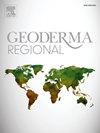Comparison of soil exchangeable calcium estimated using five extractants and near-infrared spectroscopy
IF 3.1
2区 农林科学
Q2 SOIL SCIENCE
引用次数: 0
Abstract
Soil exchangeable Ca (Caex) regulates multiple functions, including nutrient provision for plant growth, soil structure maintenance, and carbon sequestration. However, various chemical extraction methods are currently used worldwide to determine soil Caex, each with different mechanisms and purposes. The inconsistency in assessment methods complicates comparisons and predictions regarding soil Caex functions across different environments. To address this issue, we developed equations to convert soil Caex concentrations obtained from five different methods in arid regions. Furthermore, we evaluated the accuracy of predicting five soil Caex proxies and cation exchange capacity (CEC) using near-infrared reflectance (NIR) spectroscopy. The chemical extractants (i.e., sodium acetate (NaOAc), potassium chloride (KCl), sodium sulfate (Na2SO4), ethylenediaminetetraacetic acid (EDTA), and copper chloride (CuCl2)) were used on 308 soil samples representing a wide range of soil Caex, climate, and edaphic properties in arid regions. Our findings reveal that compared to the commonly used NaOAc extraction, Na2SO4 extracted a similar amount of soil Caex. In contrast, KCl extraction underestimated soil Caex, whereas EDTA and CuCl2 extractions overestimated it. Such discrepancies suggest that EDTA and CuCl2 are inappropriate for soils with Ca-bearing minerals, such as Ca carbonate. Moreover, the quantitative correlation among soil Caex values obtained through five different extractants highlights the need for careful selection based on specific environmental factors (i.e., soil pH and humidity). Notably, NIR-driven partial least squares regression outperformed support vector machine models for the estimation of soil Caex measured by five extractants (0.78 < R2 < 0.90) and CEC (R2 = 0.96). This capability positions NIR spectroscopy as an efficient and reliable tool for rapid assessment of soil Caex and CEC, particularly in arid regions. In conclusion, the quantitative relationships derived from various extraction methods provide a robust framework for comparing soil Caex values and enhancing our ability to predict changes in its functions under differing environmental conditions.

5种萃取剂与近红外光谱测定土壤交换性钙的比较
土壤交换性钙具有多种功能,包括为植物生长提供养分、维持土壤结构和固碳等。然而,目前世界范围内用于测定土壤Caex的化学提取方法多种多样,每种方法都有不同的机理和目的。评估方法的不一致性使不同环境下土壤Caex功能的比较和预测复杂化。为了解决这个问题,我们开发了转换干旱地区五种不同方法获得的土壤Caex浓度的方程。此外,我们还评估了利用近红外(NIR)光谱预测5种土壤Caex指标和阳离子交换容量(CEC)的准确性。利用化学萃取剂(即乙酸钠(NaOAc)、氯化钾(KCl)、硫酸钠(Na2SO4)、乙二胺四乙酸(EDTA)和氯化铜(CuCl2))对308个土壤样品进行了分析,这些土壤样品代表了干旱区广泛的土壤Caex、气候和土壤性质。我们的研究结果表明,与常用的NaOAc萃取相比,Na2SO4提取的土壤Caex量相似。相比之下,KCl提取低估了土壤Caex,而EDTA和CuCl2提取高估了土壤Caex。这种差异表明EDTA和CuCl2不适用于含有碳酸钙等含钙矿物的土壤。此外,通过五种不同萃取剂获得的土壤Caex值之间的定量相关性突出了根据特定环境因素(即土壤pH和湿度)仔细选择的必要性。值得注意的是,nir驱动的偏最小二乘回归在估计五种萃取剂测量的土壤Caex (0.78 <;R2 & lt;0.90)和CEC (R2 = 0.96)。这种能力使近红外光谱成为快速评估土壤Caex和CEC的有效可靠工具,特别是在干旱地区。总之,从各种提取方法中得出的定量关系为比较土壤Caex值和提高我们预测不同环境条件下其功能变化的能力提供了一个强大的框架。
本文章由计算机程序翻译,如有差异,请以英文原文为准。
求助全文
约1分钟内获得全文
求助全文
来源期刊

Geoderma Regional
Agricultural and Biological Sciences-Soil Science
CiteScore
6.10
自引率
7.30%
发文量
122
审稿时长
76 days
期刊介绍:
Global issues require studies and solutions on national and regional levels. Geoderma Regional focuses on studies that increase understanding and advance our scientific knowledge of soils in all regions of the world. The journal embraces every aspect of soil science and welcomes reviews of regional progress.
 求助内容:
求助内容: 应助结果提醒方式:
应助结果提醒方式:


